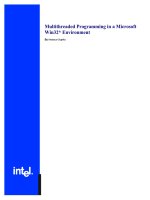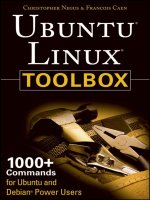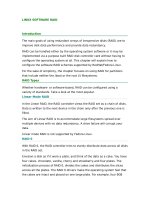Linux Computing Environment 1
Bạn đang xem bản rút gọn của tài liệu. Xem và tải ngay bản đầy đủ của tài liệu tại đây (129.73 KB, 11 trang )
Linux Computing Environment
1
Objectives
Upon completion of this module, you should be able to:
• List the four main components of a computer
• Describe the three main components of the Linux operating
system
• Identify the three most common shells in the Linux system
• Distinguish between the multitasking, multiuser, and distributed
processing capabilities of the Linux system
Discussion – Several different components work together to make up a
computer system and a networked environment. What are some of these
components?
Introduction to Linux
The UNIX operating system was originally developed at AT&T Bell Labs in
1969. It was created as a tool set by programmers for programmers. The
early source code was made available to universities all over the country.
Programmers at the University of California at Berkeley made significant
modifications to the original source code and called it BSD (Berkeley
Software Distribution) UNIX.
They sent this new version of the UNIX environment to other
programmers around the country, who then added tools and code as
they saw fit. Possibly the most important advance made to the software
by the programmers at Berkeley was the addition of networking software
which allowed the operating system to function in a local area network
(LAN).
Linux is a UNIX-like operting system, developed by Linus Torvalds, a
student at Helsinki University in Finland, in 1991. It is a modern, flexible,
mature and free operating system. Although it started life on the Intel
platform, it has since been ported to many other platforms such as
Amiga, DEC Alpha, Apple Power PC, Sun workstations, and others. Linux
boasts many other features:
• Multitasking. Linux is a true preemptive multitasking operating
system. All processes run independently of each other and leave
processor management to the kernel.
• Symmetrical multiprocessing. Linux currently scales up to 16
processors.
• Networking. Linux supports a multitude of networking protocols.
• Multiuser. Linux handles multiple users at one time logged on to a
machine.
• Advanced memory management. Traditional UNIX systems use
swapping to manage memory, where the entire memory structure of
a program is written to disk when the system is running low on
memory. Linux uses paging, a method that intelligently allocates
memory when system memory is running low by prioritizing memory
tasks.
• POSIX support. POSIX defines a minimum interface for UNIX-type
operating systems. Linux currently supports POSIX 1003.1. This
ensures that POSIX-compliant UNIX programs will port easily to Linux.
• Multiple file systems. Linux supports several different file system
formats, including DOS/Windows, OS/2, and Novell formats. This
makes interoperability a reality between operating systems.
Main Components of a Computer
The four main components of a computer are the random access
memory (RAM), the central processing unit (CPU), the input/output (I/O),
and the hard disk or other mass storage device.
Figure 1-1 Main Components of a Computer
Random Access Memory (RAM)
Random access memory, located on the memory board, is the
main
computer memory, often referred to as primary memory. Primary
memory is that part of memory where the activity of the running
system takes place. When you hear, “My system has 16 Mbytes of
memory,” the speaker is talking about primary memory or RAM.
A software program resides on the hard disk. When it is activated,
an image or copy of that program is loaded into RAM.
Images in RAM remain as long as they are needed. Once these
images are no longer required, they are overwritten by other
images. If power is lost or the system is rebooted, images in RAM
disappear.
Central Processing Unit (CPU)
The central processing unit is the computer logic chip that
executes instructions (processes) received from the primary
computer memory
(RAM). These instructions are stored in binary language.
Input/Output (I/O)
The input/output reads input from a device (such as your
keyboard) into memory, or it writes output from memory to a
device. For example, the keyboard and the mouse are the primary
user input devices; the monitor, printer, and tape drive are the
primary output devices.
Hard Disk (or Other Forms of Mass Storage)
The hard disk is a magnetic storage device where information is
stored. All files, including applications (utilities), are stored on a
hard disk.
The Linux Distributed Computing Solution
The Linux computing environment is based on the UNIX operating
system. Versions of the UNIX operating system run on many different
computer systems – microcomputers, personal computers (PCs), and
mainframes.
The operating system is a set of programs that manages all computer
operations. It also provides a link between the user and system
resources, converting requests which come from the mouse and/or
keyboard into computer operations.
There are three main parts of the operating system:
• Kernel
• Shell
• File system
Kernel
The kernel is the core of the Linux computing environment. It performs
the following functions:
The kernel is an executable file that gets loaded into memory when your system boots. It is
called /kernel/genunix .
• Manages devices, memory, and processes
• Controls the functions (transmission of information) between the
system programs (utilities) and the system hardware
• Manages functions such as:
o Swap space – A reserved part of the disk for the kernel to
use
during processing
o Daemons – Processes that perform particular system tasks
and
monitor disks and execution
o File systems – A hierarchy of directories, subdirectories, and
files
Shell
A shell is an interface between the user and the kernel. It acts as an
interpreter or translator. In other words, the shell accepts commands
issued by you, interprets these commands, and executes the appropriate
programs. Three shells are available in the Linux environment:
• Bourne shell ($) – The default shell for the Linux computing
environment. The Bourne shell was developed for the AT&T System
V.2 UNIX environment. This shell does not have aliasing or history
capabilities. It is typically used by system administrators.
• Korn shell ($) – A superset of the Bourne shell. It has many of the
Bourne shell features plus added features such as aliasing and
history. This is the industry standard for normal system users.
• C shell (%) – A shell based on the C programming language. Like
the Korn shell, it has additional features such as aliasing and
history. C shell was developed by Sun’s Bill Joy for programmers,
but is used with increasing frequency by normal system users.









